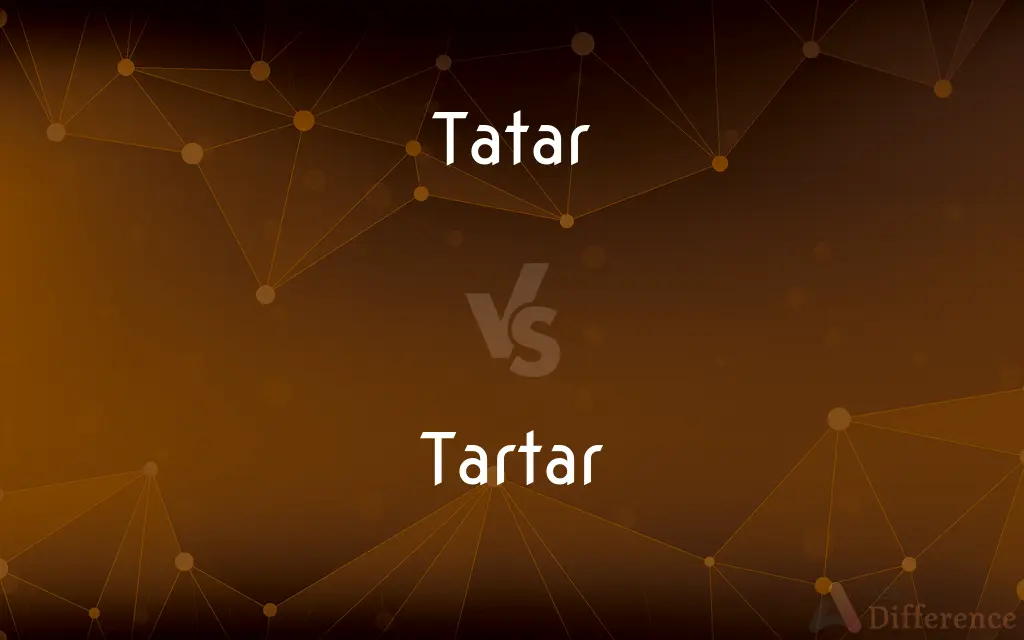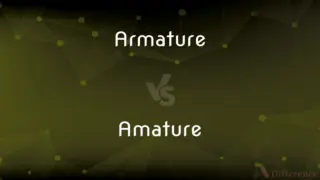Tatar vs. Tartar — What's the Difference?
By Urooj Arif & Maham Liaqat — Updated on April 19, 2024
Tatar refers to a Turkic ethnic group primarily residing in Russia and other parts of Eurasia, while tartar has multiple meanings, including a dental plaque deposit and a sauce used in cooking.

Difference Between Tatar and Tartar
Table of Contents
ADVERTISEMENT
Key Differences
Tatar describes an ethnic group with its own language and culture, predominantly found in the Republic of Tatarstan, Russia. Conversely, tartar can refer to calculus, a hard deposit that forms on teeth, or tartar sauce, a condiment commonly served with seafood. Additionally, tartar can also denote cream of tartar, a byproduct of winemaking used in baking.
While Tatars have a rich history linked to the Mongol Empire and are known for their distinct language and Islamic faith, tartar in its various non-ethnic meanings plays roles in dental health, cuisine, and even in culinary preparations as a stabilizing agent. This highlights the linguistic and functional diversity between the two terms.
The term "Tatar" has historical and cultural significance, tracing back to the Mongol-led Golden Horde, whereas "tartar" in the dental sense relates to health concerns necessitating medical attention. In the culinary world, tartar sauce adds flavor to dishes, illustrating its role in enhancing food experiences, unlike the ethnic and cultural depth associated with Tatars.
Tatars contribute to the cultural tapestry of regions they inhabit with traditions, music, and cuisine specific to their ethnic background. In contrast, tartar, when referring to cream of tartar, finds its utility in baking, acting as a leavening agent when combined with baking soda.
Comparison Chart
Definition
A Turkic ethnic group in Russia and other regions
A deposit on teeth, a sauce, or a culinary agent
ADVERTISEMENT
Cultural Significance
Rich historical and cultural heritage
No cultural significance unless in culinary contexts
Language
Tatar language, part of the Turkic language family
Not applicable, except in naming culinary items
Geographic Distribution
Primarily in Tatarstan, Russia
Worldwide, in various contexts depending on the meaning
Use
Ethnic identity
Dental health, cuisine
Compare with Definitions
Tatar
Member of a Turkic ethnic group.
The Tatar community in Kazan celebrates Sabantuy each summer.
Tartar
Used metaphorically for something rough or harsh.
His tartar temperament made negotiations difficult.
Tatar
Predominantly Muslim in faith.
The Tatars in Russia predominantly practice Islam.
Tartar
Cream of tartar, used in baking.
She used cream of tartar to stabilize the egg whites.
Tatar
The language spoken by the Tatar people.
He learned Tatar to better understand local traditions.
Tartar
A condiment made typically of mayonnaise, pickles, and herbs.
He prefers fried fish with a side of tartar sauce.
Tatar
Pertaining to the culture and heritage of the Tatars.
Tatar folk dances are an integral part of their cultural festivals.
Tartar
Historically, referred to crudely distilled crude tartaric acid.
Tartar was once collected from the bottoms of aged wine barrels.
Tatar
Historically associated with the Mongol Empire.
Tatars were part of the Golden Horde under Mongol rule.
Tartar
Hard deposit on teeth, also known as dental calculus.
Regular cleanings can help prevent tartar build-up.
Tatar
A member of a group of Turkic peoples primarily inhabiting Tatarstan in west-central Russia and parts of Siberia and Central Asia.
Tartar
See Tatar.
Tatar
Any of the Turkic languages of the Tatars.
Tartar
(Dentistry) A hard yellowish deposit on the teeth, consisting of organic secretions and food particles deposited in various salts, such as calcium carbonate. Also called calculus.
Tatar
A member of any of the Turkic and Mongolian peoples of central Asia who invaded western Asia and eastern Europe in the Middle Ages. In all senses also called Tartar.
Tartar
A reddish acid compound, chiefly potassium bitartrate, found in the juice of grapes and deposited on the sides of casks during winemaking.
Tatar
A member of the Mongolian people of central Asia who invaded Russia in the 13th century
Tartar
A red compound deposited during wine making; mostly potassium hydrogen tartrate — a source of cream of tartar.
Tatar
A member of the Turkic-speaking people living from the Volga to the Ural Mountains (the name has been attributed to many other groups)
Tartar
A hard yellow deposit on the teeth, formed from dental plaque.
Tatar
The Turkic language spoken by the Tatar people living from the Volga to the Ural Mountains
Tartar
(dated) A fearsome or angrily violent person.
Tartar
A reddish crust or sediment in wine casks, consisting essentially of crude cream of tartar, and used in marking pure cream of tartar, tartaric acid, potassium carbonate, black flux, etc., and, in dyeing, as a mordant for woolen goods; - called also argol, wine stone, etc.
Tartar
A correction which often incrusts the teeth, consisting of salivary mucus, animal matter, and phosphate of lime.
Tartar
A native or inhabitant of Tartary in Asia; a member of any one of numerous tribes, chiefly Moslem, of Turkish origin, inhabiting the Russian Europe; - written also, more correctly but less usually, Tatar.
Tartar
A person of a keen, irritable temper.
Tartar
See Tartarus.
Tartar
Of or pertaining to Tartary in Asia, or the Tartars.
Tartar
A salt used especially in baking powder
Tartar
A fiercely vigilant and unpleasant woman
Tartar
A member of the Mongolian people of central Asia who invaded Russia in the 13th century
Tartar
An incrustation that forms on the teeth and gums
Common Curiosities
Can cream of tartar be made at home?
Cream of tartar is a byproduct of winemaking and is not typically made at home but bought as a culinary ingredient.
What is dental tartar and how does it affect health?
Dental tartar is a hardened form of dental plaque that can lead to gum disease if not removed.
What role do Tatars play in Russia today?
Tatars are the second-largest ethnic group in Russia, contributing significantly to the cultural diversity of the nation.
What is the origin of the Tatar people?
The Tatars originated from the Turkic-speaking peoples in Eurasia, with historical ties to the Mongol Empire.
How is tartar sauce commonly used?
Tartar sauce is typically served with seafood, especially fried fish.
Is tartar sauce the same worldwide?
While the basic ingredients are similar, regional variations of tartar sauce may include additional ingredients like capers or olives.
How is the Tatar language preserved and promoted?
The Tatar language is supported through education, media, and cultural initiatives, particularly in Tatarstan.
How can one prevent tartar build-up on teeth?
Regular brushing, flossing, and professional dental cleanings can prevent tartar build-up.
Are Tatars only found in Russia?
While most Tatars live in Russia, significant communities also exist in other parts of the world, such as Uzbekistan and Kazakhstan.
What festivals are significant to Tatars?
Sabantuy, a summer festival, is one of the most important cultural celebrations for Tatars, featuring traditional games and performances.
What are some traditional Tatar dishes?
Traditional Tatar dishes include chak-chak, a sweet pastry, and kystybyi, a stuffed pancake.
What is the historical significance of the Tatars in the Mongol Empire?
Tatars were crucial members of the Mongol Empire, contributing to its military and administrative functions.
What impact does cream of tartar have in baking?
Cream of tartar is used as a stabilizing agent in recipes like meringues and snickerdoodle cookies.
What is the significance of tartaric acid in winemaking?
Tartaric acid helps control the pH level in wine, impacting its color, taste, and texture.
How do dietary habits affect tartar formation?
Consuming sugary and starchy foods can increase plaque formation, which when hardened turns into tartar.
Share Your Discovery

Previous Comparison
Armature vs. Amature
Next Comparison
Soccer vs. HandballAuthor Spotlight
Written by
Urooj ArifUrooj is a skilled content writer at Ask Difference, known for her exceptional ability to simplify complex topics into engaging and informative content. With a passion for research and a flair for clear, concise writing, she consistently delivers articles that resonate with our diverse audience.
Co-written by
Maham Liaqat














































